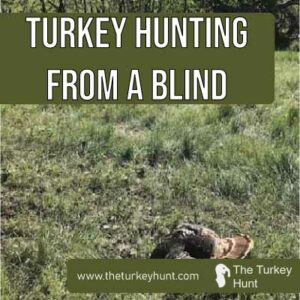Many hunters of all ages enjoy turkey hunting from a blind. It’s relatively straight forward, offers a very high level of cover and concealment, and allows the hunter to move around a little bit more than they would normally get away with without a blind. That said, hunting from a blind comes with its’ own set of challenges that we will cover in this guide on how to turkey hunt from a blind.
Turkey hunting from a blind is one of the most exciting ways to hunt. The thrill of being able to sneak up on a bird, or call it in until you can shoot, is unlike any other experience.
However, there’s more than one way to go about turkey hunting. While some people like wearing camo and sneaking around in the woods (or suburbs), others prefer sitting still and calling from a blind.
Calling from a blind can be more effective if done correctly, but there are some important things you need to know before doing so!
What is a Hunting Blind?
A turkey hunting blind is a camouflaged structure that hunters can use to hide from the game. Turkey hunting blinds can be made from a variety of materials, including wood, metal, or fabric, and are often designed to blend in with their surroundings.
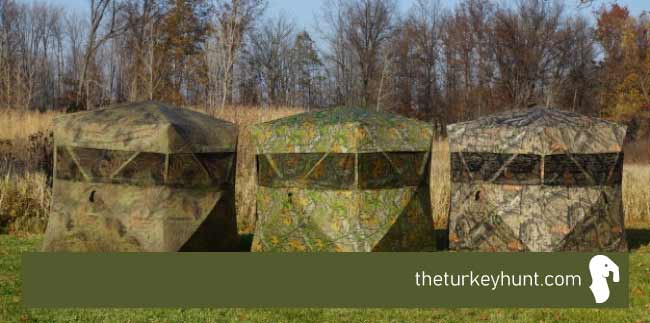
The main purpose of a turkey hunting blind is to allow hunters to bring their prey down with ease by hiding themselves from sight. However, they are not only used for turkeys! You can also use them to hunt other birds like quail, pheasant, duck, as well as larger game like deer.
Do Turkeys Notice Blinds?
One of the biggest questions you may have about the behavior of turkeys is whether or not they notice blinds when hunting. After all, turkeys have outstanding vision, but is it good enough to tell the difference between a blind and the surrounding landscape?
This will depend on the exact time of day you are hunting, as well as how comfortable the turkey feels in its surroundings, and the camouflage of the blind itself.
Turkeys are very curious creatures, and they can even approach a blind to investigate. If you’ve set up your blind correctly, this shouldn’t be too much of an issue—but if the turkey is feeling threatened by something else nearby (like another hunter), it may simply fly away without giving your blind so much as a glance.
Why Hunt Turkeys From a Blind?
If you’re new to turkey hunting, you may be wondering why hunters often choose to set up a blind rather than just sitting in the open. After all, turkeys can see incredibly well.
The fact is, even though turkeys can see long distances, they have poor depth perception. This means that they can’t always tell how far away something is. When you’re hidden in a blind, the turkey doesn’t know how far away you are and is less likely to be spooked.
In addition, sitting in a blind gives you the element of surprise. You can wait until the turkey is close enough where it would otherwise be very difficult to take a shot if it saw you.
Another advantage of hunting from a blind is that it allows you to move around without being seen. If you’re careful, you can stand up or even walk to another spot without being detected. This can be helpful if the turkey is on the other side of some obstacles and you need to get closer for a shot.
Of course, there are also some disadvantages to hunting from a blind. The main one is that it limits your field of view. You won’t be able to see as much of the area around you, which means that you could miss seeing a turkey that was coming in from another direction.
Another consideration is that setting up and taking down a blind takes time and effort. If you’re only going to be in an area for a short time or if you’re hunting on public land where you can’t leave anything behind, it might not be worth the trouble to set up a blind.
Related: Turkey Hunting for Beginners
As with most things in hunting, whether or not to hunt from a blind is a personal decision. Some hunters never use them, while others wouldn’t think of going without one. The best way to decide whether or not it’s right for you is to try it and see how it goes. To be honest, it might not be fun to hunt turkeys from a blind for some people, but it sure will help make sure you go unnoticed.
Turkey Hunting From a Ground Blind: The Benefits
A turkey hunting blind can provide many benefits to the hunter. It can give you the element of surprise, help you stay concealed, and provide a comfortable place to wait for your turkey.
The element of surprise is one of the most important aspects of hunting, and a blind can give you the upper hand. A well-concealed blind will allow you to get close to turkeys without being detected. When done correctly, birds will never suspect your presence – ever.
After all, the hardest part of hunting beard draggers is being seen, right? Imagine being able to eliminate this possibility. Welcome to hunting from a blind.
In addition to the element of surprise, blind can help you stay concealed from the turkeys’ sharp eyesight. Natural camouflage patterns can help break up your outline and make it harder for turkeys to spot you.
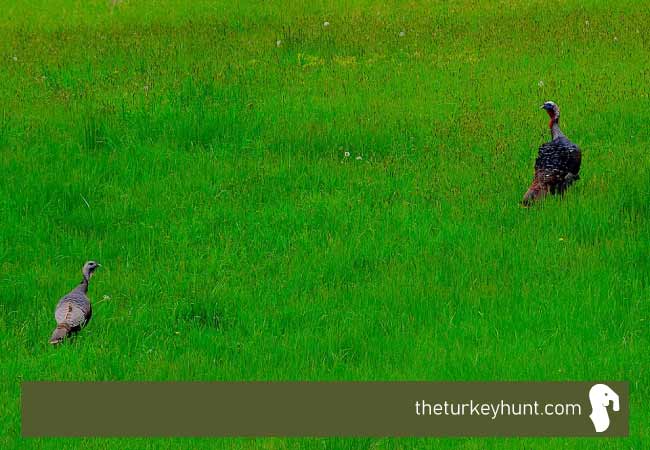
Hunting from a blind can also be more comfortable than hunting in an open field. A blind can provide shelter from the elements and a place to rest between long periods of waiting. Some hunters even bring chairs or cots into their blinds so they can relax and nap while they wait for their turkey.
Whether you’re new to turkey hunting or a seasoned veteran, consider giving hunting from a blind a try. It could give you the edge you need to bag that trophy gobbler.
Different Types of Blinds for Turkey Hunting
There are many different types of blinds available for turkey hunting. They all come with their own advantages and disadvantages.
Some of the most popular include ground blinds, elevated platform blinds, and pop up blinds.
Pop Up Blinds
A pop up blind is good for those on the run, or in a hurry. Out for only a morning and didn’t have time to set up your blind earlier? Consider using a pop up blind.
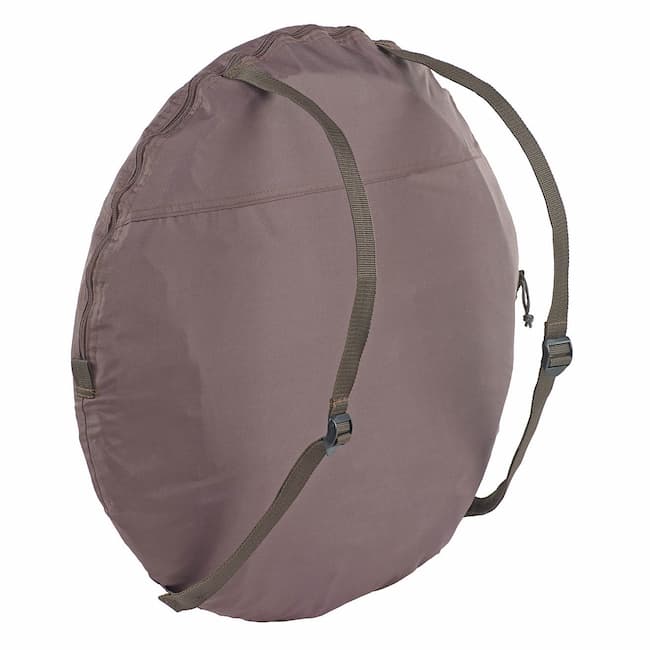
These blinds fold into themselves, like a pop up tent, and can be put inside a carrying bag. They are lightweight, and can expand into a full blown blind very quickly. They are usually a bit smaller in size to make up for their mobility.
Ground Blinds
Ground blinds are the simplest and most common type of blind, and are typically made from camouflaged fabric or netting stretched over a frame of poles.
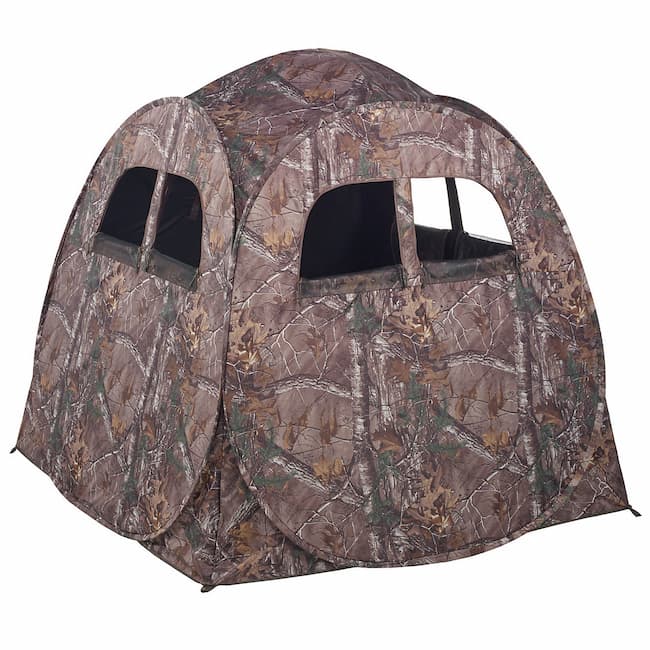
They can come in a variety of shapes and sizes. As long as your ground blind is camouflaged properly, you’ll be good to go. Consider using a chair or stool of some kind while inside – you’ll thank me later.
Elevated Blinds
Elevated platform blinds offer an elevated shooting position and are typically made from a metal or wood platform with a surrounding rail and wall of camouflage netting or fabric.
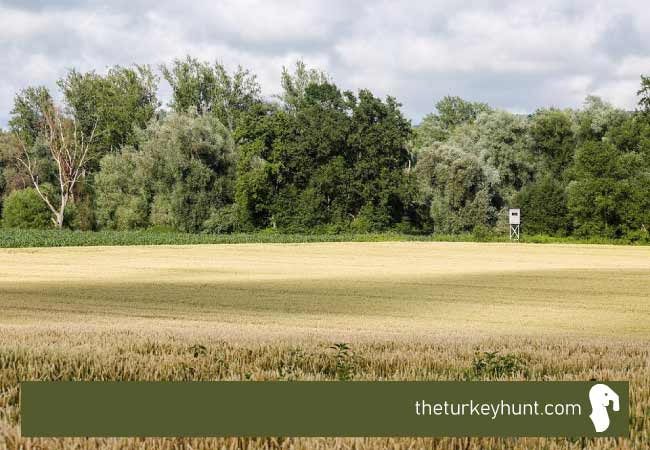
While possible to use for turkey hunting, elevated blinds are more popular for deer hunting, or even hog hunting. Even so, people have nailed some massive birds from these types of blinds.
Mirror Blinds (Ghost Blind)
Imagine being able to truly mimic the surroundings of your landscape. This is what a mirror blind accomplishes. It (literally) shows a mirror image of what is around the immediate area that this blind is setup in.
I’ve got to admit: these things look pretty incredible, and seem relatively simple to use. I have personally never used a mirror blind for hunting, but I have been wanting to try one out for a little while now.
What Materials are Blinds Made Of?
As you just read, there are many different types of blinds, which means that the materials used to make them are going to vary, a lot. At a minimum, a blind needs to provide some form of concealment. A majority of blinds use some form of camouflage printed neoprene. This thin material is suitable to make the blind lightweight, but also can be printed on.
The printed camouflage patterns provide your concealment from the birds.
Is a Turkey Hunting Blind Different From Other Blinds?
Not really. Hunting from a blind is, more or less, the same. Sure, if you deer hunt your blind may be elevated, but it’s still hunting from a blind. The same concept, and rules, apply. It really is no different. The only difference is the type of game you are hunting for – that’s about it.
How to Set Up a Permanent Turkey Hunting Blind
When you go turkey hunting, one of the best ways to do so is from a blind. This allows you to stay hidden from Turkey’s keen eyesight and gives you the element of surprise.
To set up a home made turkey hunting blind, you will need:
- 4×4 posts
- camouflage netting
- staples
- hammer
- blind chair
To set up your blind, start by hammering the 4×4 posts into the ground in a square or rectangle shape. The size of your blind will depend on how many people will be using it, but a good rule of thumb is to make it at least 5 feet by 5 feet.
Once the posts are in place, stretch the camouflage netting over the frame and secure it with staples. Make sure there are no gaps in the netting, as this will give away your position.
Place the blind chair inside the frame and set up your decoys around the perimeter of the blind.
As always, make sure the set this blind up in a good spot where known movement of the birds has occurred. A tree line next to a field is always a great spot.
Where to Set Up Your Blind
If you want to be successful in turkey hunting from a blind, you need to put it in the right location. It’s not as simple as just finding any old place and setting up camp. You need to find a spot that works for both you and your prey.
A good place to start is by identifying a field that has at least one large tree, preferably with low-hanging branches. You can then place your blind in the vicinity of this tree and use it as a blind anchor point. Turkey are very territorial animals, so they will often fly away if they feel threatened by other hunters or prey animals nearby—but they won’t leave their territory without first investigating what’s going on.
The best place to set up a blind is in an area that has a lot of turkey activity. You need to locate your blind so that it’s close enough for you to get a good look at the birds, but far enough away that they don’t detect your presence.
This may mean walking several miles in one direction before you find what you’re looking for. If possible, try to set up camp near some kind of feature that turkeys are likely to use—like a creek bed or field full of grasshoppers (which they love).
How to Camouflage a Blind the Right Way
One of the most important things to consider when turkey hunting from a blind is a proper form of camouflage. The blind should be covered with foliage so that it blends in with the surroundings, and any exposed parts should be painted in a pattern that includes leaves and branches.
The goal is to make the blind invisible to the turkey, so it’s important to take the time to do it right.
For example, if you are hunting in grass lands, you probably shouldn’t use a bunch of vibrant colors that mimic forests from the northwest, and vice versa.
Want to Step it Up a Level? Use Turkey Decoys.
Turkey decoys can be an important tool for turkey hunters, especially when used in conjunction with a hunting blind. By using decoys, hunters can attract turkeys to their location and then ambush them from the blind.
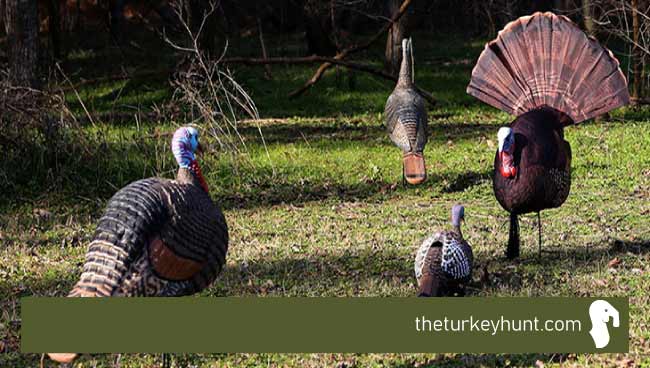
Decoys can be very effective in attracting turkeys, but they can also be a major distraction. If you are using decoys, make sure that they are placed in an area where they will not block your view or impede your ability to shoot.
There are a few things to keep in mind when using decoys in conjunction with a turkey hunting blind.
- First, it is important to set up the decoys in a way that will realistically simulate a flock of turkeys. This usually means placing the decoys around 10-20 yards away from the blind, in an open area where there is plenty of room for the birds to land.
- The decoy must be visible to other birds, too – not just you.
- It is also important to make sure that the decoys are visible from inside the blind.
- Finally, once the decoys are set up and everything is ready, it is important to be patient and wait for the birds to come within range before taking a shot.
Over-eagerness is one of the biggest mistakes that turkey hunters make, so remember to be patient and wait for the perfect opportunity before pulling the trigger.
Pros and Cons of Hunting from a Blind
There are several advantages to hunting from a blind:
- A blind can provide camouflage and concealment for the hunter, making it easier to get close to the game.
- While this tip doesn’t apply to turkey hunting, a blind can help reduce the hunter’s scent, which can be helpful in areas where game is particularly sensitive to smell.
- Hunting from a blind can also be less physically demanding than other types of hunting, making it a good option for hunters who are not in peak physical condition. All you do is get to your blind, sit down, and wait!
- Finally, hunting from a blind can be a more relaxed and comfortable experience than other types of hunting, which can be beneficial for hunters who are new to the sport or who do not enjoy the more strenuous aspects of hunting. You can move around much more freely without worrying about spooking the birds.
There are also a few potential disadvantages to hunting from a blind, which include the following:
- First, if the blind is not set up correctly, or if it is not camouflaged properly, the turkey may be able to see the hunter inside and become alarmed.
- Using a blind can be expensive, difficult to set up, and complex to use.
- Finally, if the blind is not large enough, the hunter may have difficulty getting a clear shot at the turkey.
Ultimately, whether or not to use a turkey hunting blind is a personal decision that each hunter must make based on their own preferences and needs.
Tips for Success When Turkey Hunting From a Blind
Whether you are a beginner or a seasoned pro, these tips will help you have a successful Turkey hunt from a blind.
- Be patient: Turkeys are notoriously difficult to pattern, so it might take some time before you see one. Be patient and wait for the right opportunity.
- Make sure you are camouflaged: A big part of turkey hunting is being able to blend in with your surroundings. Make sure you are using effective camouflage and that you are staying still while waiting for the turkey.
- Be prepared to shoot: When the turkey finally does show up, be prepared to take the shot. This can happen when you least expect it – trust me. Make sure your gun is unloaded until you are ready to shoot and practice shooting from a sitting position before heading out on your hunt.
- Beware of your scent: Scent is one of the biggest factors in whether or not you will be successful when hunting from a blind. Make sure to use scent-eliminating products.
Mistakes to Avoid
- Avoid big blinds. If you’re going to be hunting from a blind, it’s important to have one that will actually fit all of your equipment and allow you to move around freely. Too big of a blind will make it hard for you to see things clearly and comfortably, plus you’ll be easy for the animals around you to spot.
- Avoid tiny blinds. While smaller is better than bigger when talking about size there are limits—you don’t want something so tiny as to not even fit in with the rest of your gear! A small blind could also lead an animal right up next to you without them realizing what they’re doing until it’s too late because they think they’re alone in the woods with no one else nearby at all times (which would be really scary).
- Avoid tall or short ones (or any other dimension besides length!). There’s no reason why anyone would ever want these kinds of incorrect dimensions on their hunting equipment unless maybe they were just trying really hard not to waste money but still wanted some kind of product nonetheless? Maybe someone should invent something like this! Then again maybe not since people don’t like wasting money either…
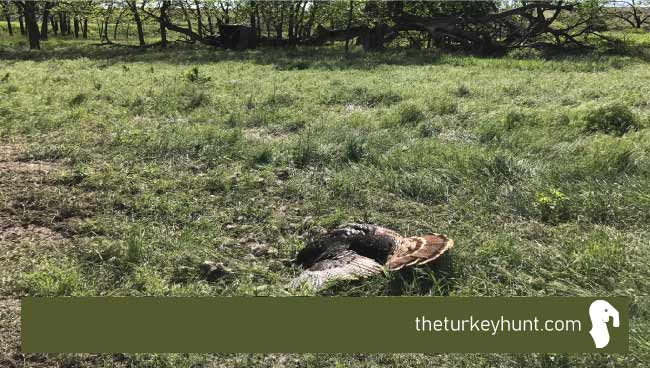
Some other things you would want to avoid are:
- Don’t shoot until you have a clear shot and you are sure of your target.
- Don’t move around too much inside the blind or you will scare the turkeys away.
- Don’t make too much noise or the turkeys will be alerted to your presence.
Safety Pointers When Blind Hunting
The biggest safety pointer here is to be aware of your surroundings at all times, and be aware of what is in front of, and behind, your target. Since turkey hunting from a blind can severely limit your field of vision, you have to be extra careful.
People are also more likely to rest their guns on things within the blinds while they wait. Never, ever, rest a fully loading gun on the ground that is not on safe. An accidental bump on the trigger well in the wrong position can lead to a devastating outcome.
Summary – Turkey Hunting From a Blind
To quickly summarize everything, turkey hunting from a blind is a great way to experience the hunt without having to move around much. You can sit down, move a bit more freely, and be more comfortable within a blind.
I highly recommend trying this type of hunting for beginners learning how to hunt birds. It can be a very enjoyable experience, and make your chances of a successful hunt go up dramatically.

